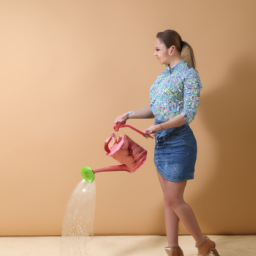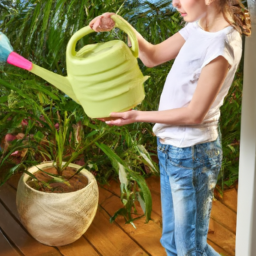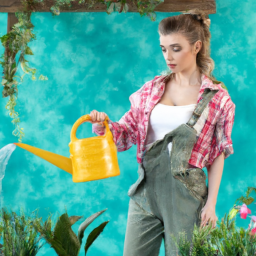
Watering gardens is a crucial aspect of maintaining a healthy and thriving outdoor space. Whether you have a small balcony garden or a sprawling backyard oasis, proper watering techniques can make all the difference in the growth and health of your plants. From determining the best time of day to water to choosing the right tools for the job, there are many factors to consider when it comes to keeping your garden hydrated. In this blog post, we will explore the ins and outs of watering gardens, offering tips and tricks to help you achieve a lush and vibrant outdoor space. So grab your watering can and let’s dive in!
Benefits of Properly Watering Gardens
Introduction
Properly watering your garden is essential for the health and growth of your plants. Many gardeners underestimate the importance of watering and often end up either overwatering or underwatering their plants. In this guide, we will discuss the benefits of properly watering your garden and provide you with some tips on how to do it effectively.
Prevents Underwatering
Underwatering your garden can have detrimental effects on your plants. When plants do not receive enough water, they can become stressed and wilt. This can lead to stunted growth and poor fruit or flower production. Proper watering ensures that your plants receive the necessary moisture to thrive and flourish.
Additionally, underwatering can make plants more susceptible to pests and diseases. When plants are stressed due to lack of water, they are less able to defend themselves against harmful insects and pathogens. By properly watering your garden, you can help your plants stay healthy and resilient.
To prevent underwatering, it is important to water your garden deeply and infrequently. This encourages plants to develop deep root systems, which allows them to access water and nutrients more effectively. Watering deeply also helps to prevent water runoff and encourages the growth of drought-resistant plants.
Prevents Overwatering
Overwatering is just as harmful to plants as underwatering. When plants receive too much water, their roots can become waterlogged, leading to root rot and other diseases. Overwatering can also deprive plants of oxygen, which is essential for their growth and development.
Properly watering your garden helps to prevent overwatering by ensuring that plants receive the right amount of moisture. One way to avoid overwatering is to water your garden in the morning, allowing excess water to evaporate during the day. It is also important to water plants at the base, rather than from above, to prevent water from sitting on the leaves and causing fungal diseases.
Another tip to prevent overwatering is to use a moisture meter to monitor the soil moisture levels in your garden. This can help you determine when your plants need water and prevent you from overwatering out of fear of underwatering.
Promotes Healthy Growth
Properly watering your garden is essential for promoting healthy growth in your plants. When plants receive the right amount of water, they are able to absorb nutrients more effectively and grow vigorously. Proper watering also helps plants to photosynthesize efficiently, which is essential for their overall health and development.
In addition to promoting healthy growth, proper watering can also improve the flavor and quality of fruits and vegetables. When plants are well-hydrated, they are able to produce sweeter and juicier fruits, making your harvest more enjoyable and flavorful.
By following these tips and properly watering your garden, you can ensure that your plants thrive and flourish. Remember to water deeply and infrequently, monitor soil moisture levels, and water at the base of plants to prevent overwatering. With a little care and attention, your garden will be healthy and vibrant all season long.

Best Practices for Watering Gardens
Understanding the Water Needs of Plants
Before diving into the specifics of watering your garden, it’s important to understand the water needs of different types of plants. Some plants, such as succulents and cacti, require very little water and can actually be harmed by overwatering. On the other hand, plants like tomatoes and cucumbers need consistent moisture to thrive. Take the time to research the water requirements of the plants in your garden so you can tailor your watering schedule accordingly.
One way to determine if your plants need water is to stick your finger into the soil. If the top inch or so feels dry, it’s likely time to water. You can also invest in a moisture meter to get a more precise reading of the soil moisture levels. Remember that it’s better to underwater than overwater, as too much water can lead to root rot and other issues.
In addition to the water needs of your plants, consider the climate and weather conditions in your area. Plants will need more water during hot, dry periods, while they may need less during cooler, rainy weather. Adjust your watering schedule accordingly to ensure your plants are getting the right amount of moisture.
Choosing the Right Watering Method
There are several different methods you can use to water your garden, each with its own pros and cons. One of the most common methods is hand watering with a hose or watering can. This allows you to target specific plants and areas that need water, but it can be time-consuming, especially for larger gardens.
Drip irrigation systems are another popular option, as they deliver water directly to the roots of plants, reducing evaporation and water waste. These systems can be set on a timer for automated watering, making them a convenient choice for busy gardeners. Soaker hoses are similar to drip irrigation systems but are less precise in their water delivery.
Sprinklers are a good option for watering large areas of the garden quickly, but they can be less efficient than drip irrigation systems. Overhead watering can also lead to water waste and increased risk of disease, as the foliage of plants stays wet for longer periods of time. Consider the size and layout of your garden, as well as the water needs of your plants, when choosing a watering method.
Establishing a Watering Schedule
Once you understand the water needs of your plants and have chosen a watering method, it’s time to establish a watering schedule. Consistency is key when it comes to watering gardens, as erratic watering can stress plants and lead to issues like blossom end rot and wilting.
During the growing season, most plants will need about 1 inch of water per week, either from rainfall or supplemental watering. This can vary depending on the type of plant, soil conditions, and weather patterns, so be sure to monitor your garden regularly and adjust your watering schedule as needed.
Early morning is the best time to water your garden, as it allows the water to penetrate the soil before the heat of the day evaporates it. Avoid watering in the evening, as this can promote fungal diseases by keeping the foliage wet overnight. Remember to water deeply and infrequently, encouraging plants to develop deep root systems that are more resilient to drought.

Efficient Watering Techniques for Healthy Gardens
As an expert in gardening, I understand the importance of proper watering techniques to ensure the health and vitality of your plants. In this guide, I will share with you some efficient watering techniques that will help you maintain a beautiful and thriving garden.
Understanding Your Garden’s Water Needs
Before you start watering your garden, it is important to understand the water needs of your plants. Different plants have different watering requirements, so it is essential to group them according to their water needs. For example, plants that require frequent watering should be grouped together, while drought-tolerant plants can be grouped separately.
Another factor to consider is the type of soil in your garden. Sandy soil drains water quickly, while clay soil retains water for longer periods. Knowing your soil type will help you determine how often and how much to water your plants.
Lastly, consider the weather conditions in your area. Plants will need more water during hot and dry weather, while they may require less water during cooler and rainy seasons. Monitoring the weather forecast will help you adjust your watering schedule accordingly.
Watering Techniques
One of the most efficient watering techniques is drip irrigation. This method delivers water directly to the roots of the plants, minimizing water waste through evaporation and runoff. Drip irrigation systems can be set on a timer to ensure consistent and efficient watering.
Another effective watering technique is mulching. Mulch helps retain moisture in the soil, reducing the frequency of watering needed. Organic mulches such as straw, bark, or compost not only conserve water but also improve soil quality as they break down.
When watering your garden, it is important to water deeply but infrequently. This encourages plants to develop deep root systems, making them more resilient to drought conditions. Watering in the early morning or late evening also helps reduce water loss due to evaporation.
Conserving Water
To conserve water in your garden, consider collecting rainwater in a barrel or installing a rainwater harvesting system. This collected water can be used to irrigate your garden, reducing your reliance on municipal water sources.
Another way to conserve water is by using a soaker hose or a watering can instead of a sprinkler. Soaker hoses deliver water directly to the base of the plants, minimizing water waste. Watering cans allow you to target specific areas that need watering, avoiding unnecessary water runoff.
Lastly, consider planting native and drought-tolerant plants in your garden. These plants are adapted to the local climate and require less water to thrive. By incorporating these plants into your garden, you can create a beautiful and sustainable landscape that conserves water.
Highlights of this article
Watering your garden is a crucial task that can make or break the success of your plants. It’s important to understand the specific watering needs of each type of plant in your garden, as overwatering or underwatering can lead to stunted growth or even plant death. One key tip is to water your garden in the morning or evening when the sun is not as strong, to prevent water from evaporating too quickly and ensure that your plants can absorb the moisture they need.
Another important aspect of watering your garden is to water deeply and infrequently, rather than giving your plants frequent shallow waterings. This encourages the roots to grow deeper into the soil, making them more resilient to drought conditions. It’s also important to water at the base of the plant rather than overhead, to prevent diseases from spreading and ensure that the water goes directly to the roots where it’s needed most. By following these simple tips and paying attention to the individual needs of your plants, you can ensure a healthy and thriving garden all season long.
Here are this week’s Top Questions and Answers
Q1: How often should I water my garden?
A1: The frequency of watering your garden depends on various factors such as the type of plants, soil type, weather conditions, and the time of year. In general, most gardens require watering 1-2 times per week, but it’s important to monitor the soil moisture levels and adjust accordingly.
Q2: What is the best time of day to water my garden?
A2: The best time to water your garden is early in the morning, preferably before 10 am. This allows the plants to absorb the water before the heat of the day evaporates it. Avoid watering in the evening as it can promote fungal diseases due to prolonged moisture on the leaves.
Q3: How much water does my garden need?
A3: The amount of water your garden needs depends on factors such as plant type, soil type, and weather conditions. As a general rule of thumb, most gardens require about 1 inch of water per week, either from rainfall or irrigation. Use a rain gauge to measure how much water your garden is receiving.
Q4: Should I water my garden with a hose or a sprinkler system?
A4: Both hose watering and sprinkler systems can be effective methods for watering your garden. However, using a soaker hose or drip irrigation system is often more efficient as it delivers water directly to the roots of the plants, minimizing water waste from evaporation and runoff.
Q5: How can I tell if my garden needs more water?
A5: One way to determine if your garden needs more water is to check the soil moisture level. Stick your finger into the soil about 1-2 inches deep. If it feels dry, it’s time to water. Also, look for signs of wilted or yellowing leaves, which can indicate dehydration in the plants.

James Wong is a renowned ethnobotanist, plant scientist, and local television presenter. With a passion for demystifying plant science, he is known for translating complex botanical concepts into practical advice for everyday plant enthusiasts. James’s expertise spans from traditional gardening to cutting-edge plant technologies, making his insights accessible and informative.


